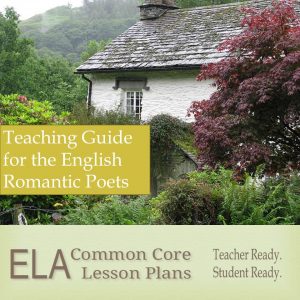Enjoy this analysis of “The Lamb” by William Blake. But first, the poem. For a lesson plan on how to do a poetry analysis, follow the link.

Yes, you can spend multiple class periods on poetry without the dreaded 2-minute reading followed by 49 minutes of stammering. The British Romanticism Teaching Guide includes an overview of British Romanticism and an analysis of selected poems by William Blake, William Wordsworth. Samuel Taylor Coleridge, Lord Byron, Percy Shelley and John Keats.
The Lamb
Dost thou know who made thee?
Gave thee life, and bid thee feed,
By the stream and o’er the mead;
Gave thee clothing of delight,
Softest clothing, woolly, bright;
Gave thee such a tender voice,
Making all the vales rejoice?
Little Lamb, who made thee?
Dost thou know who made thee?
Little Lamb, I’ll tell thee.
He is called by thy name,
For He calls Himself a Lamb.
He is meek, and He is mild;
He became a little child.
I a child, and thou a lamb,
We are called by His name.
Little Lamb, God bless thee!
Little Lamb, God bless thee!

Imagine having 11 complete poetry units with handouts and lesson plans completed. You don’t need to imagine. These units are teacher ready and student ready. Just print, make copies, and accept accolades from colleagues and students.
“The Lamb” Analysis
Doing an analysis of “The Lamb” by William Blake starts with printing the poem. It can be found above. Print it out and take notes.
- Rhyme Scheme – aabbccddeeaa aabcddcbaa – the couplets combined with short line lengths and the repetition of the first two and last two lines of each stanza produce a song-like quality to the poem. The poetic form reflects the content, a simple, yet profound question asked to a child.
- The first stanza contains a question to a child. The second stanza gives the answer.
- The first stanza contains a metaphor comparing the child to a lamb. The second stanza contains a metaphor comparing lamb to Jesus Christ. Lamb in the second stanza is also a Biblical allusion. Thee is repeated at the end of eight lines in the poem. The first two lines repeat. The last two lines of the first stanza repeat. The first two and last two lines repeat respectively. Why? There is a progression. The first stanza presents the question “Who made thee?” The first two lines of the second stanza brings good news, being I know the answer and “I’ll tell thee.” The next six lines express that the Lamb of God made him, which leads to the poem’s speaker’s joyous exclamation of “God bless thee!”
- Stanza 1 contains the pastoral images of stream, vales, and mead and paints an ideal picture of infancy– “clothing of delight,” “wooly bright,” “tender voice.”
- Stanza 2 contains a religious-philosophical discussion on human creation.
“The Lamb” Analysis Paragraph
“The Lamb” by William Blake provides a simple and profound answer to a simple and profound question: Who made us? (the topic sentence states the title and author of the poem as well as the poem’s theme). Because the poem addresses a child it takes on the form of a child’s song, containing rhymed couplets and repetition (we’ve taken a fact about the poem and explained the significance of the fact to the poem’s overall meaning). Because the poem addresses a child, the answer to the question must be at the level a child can understand. In this case, the Lamb–meaning the Lamb of God, made thee, isn’t that great? (this is the simple answer alluded to in the topic sentence).
The answer, although understood by the child, deals with a philosophical religious question that scholars have discussed for centuries (this addresses the profound answer mentioned in the topic sentence), leading one to think that perhaps we all need to become like a little child to understand our eternal nature (note how the author of this paragraph adds a Biblical allusion and ends his paragraph by restating the poem’s theme and tying it into his topic sentence).
An analysis of “The Lamb” by William Blake from cannot be fully understood without addressing “The Tyger,” the companion poem found in Songs of Experience. Click the link for an analysis of “The Tyger”
